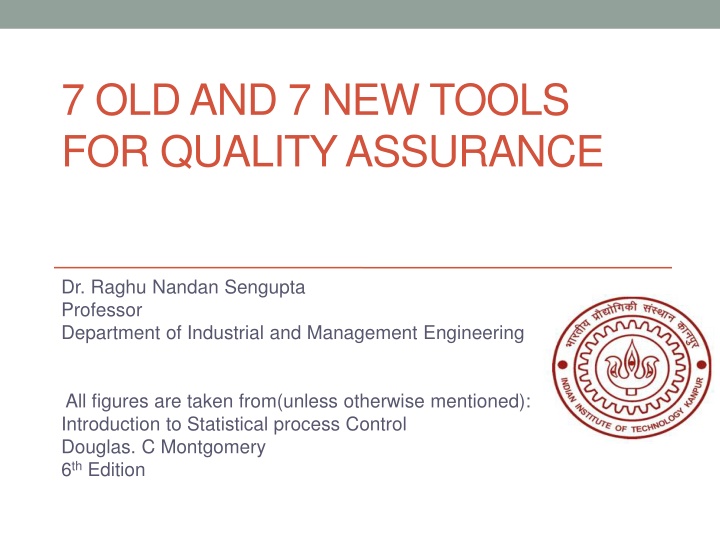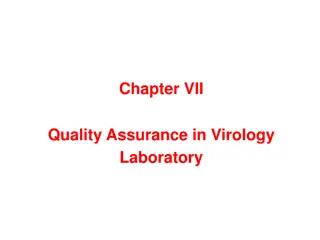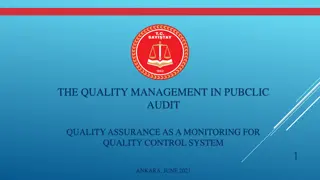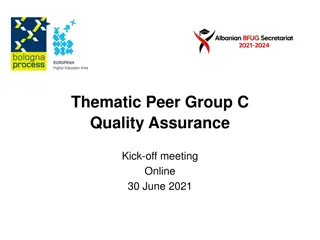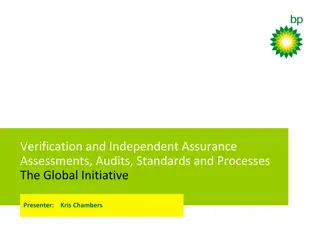7 Old and 7 New Tools for Quality Assurance
In this detailed guide, Dr. Raghu Nandan Sengupta introduces the 7 old tools for quality assurance, covering essential methods like histograms, check sheets, Pareto charts, and more. Learn about stem-and-leaf plots, histograms, and their practical applications in statistical process control systems. Explore the significance of each tool in reducing variability, eliminating waste, and enhancing quality assurance practices.
Download Presentation

Please find below an Image/Link to download the presentation.
The content on the website is provided AS IS for your information and personal use only. It may not be sold, licensed, or shared on other websites without obtaining consent from the author.If you encounter any issues during the download, it is possible that the publisher has removed the file from their server.
You are allowed to download the files provided on this website for personal or commercial use, subject to the condition that they are used lawfully. All files are the property of their respective owners.
The content on the website is provided AS IS for your information and personal use only. It may not be sold, licensed, or shared on other websites without obtaining consent from the author.
E N D
Presentation Transcript
7 OLD AND 7 NEW TOOLS FOR QUALITY ASSURANCE Dr. Raghu Nandan Sengupta Professor Department of Industrial and Management Engineering All figures are taken from(unless otherwise mentioned): Introduction to Statistical process Control Douglas. C Montgomery 6thEdition
7 Old tools for Quality Assurance A comprehensive statistical process control system uses seven tools to reduce variability and eliminate waste 1. Histogram or stem-and-leaf plot 2. Check sheet 3. Pareto chart 4. Cause-and-effect diagram 5. Defect concentration diagram 6. Scatter diagram 7. Control chart(this will be discussed separately in greater detail in the next module of this course)
Stem and Leaf Plot Graphical representation of data Let there be a set of 9 numbers {101,102,103,104,105,106,107,108,109} To construct a stem and leaf plot, the numbers are divided into two parts the stem and the leaves Here the stem will be 10 and leaves will be {1,2,3,4,5,6,7,8,9} Generally number of stems should be less
Stem and Leaf Plot Above example is ordered which makes it easy to find out the percentiles the 100 kth percentile is a value such that at least 100 k% of the data values are at or below this value and at least 100 (1 k)% of the data values are at or above this value
Histogram Continuous data is divided into intervals which are called class intervals, cells or bins The number of bins does not have any agreed rule One heuristic is h=1+log2n where n=sample size and h= number of bins Gives a visual impression of the shape of the distribution of the measurements and some information about the inherent variability in the data Histogram is best suited for larger data sets containing, say, 75 to 100 or more observations Choice of number of bins becomes less influential in determining the shape of the distribution
Check Sheet Measure of DMAIC collection of data Check sheet is used to collect data in an organized way Specify the type of data to be collected, the part or operation number, the date, the analyst, and any other information useful in diagnosing the cause of poor performance A trial run to validate the check sheet layout and design
A Check Sheet to Record Defects in Aerospace Time-oriented summary is particularly valuable in looking for trends or other meaningful patterns
Pareto Chart A frequency distribution (or histogram) of attribute data arranged by category Used both in Measure and Analyze step of DMAIC
Pareto Chart Pareto chart does not automatically identify the most important defects, but only the most frequent When the list of defects contains a mixture of those that might have extremely serious consequences and others of much less importance, one of two methods can be used: Use a weighting scheme to modify the frequency counts. Accompany the frequency Pareto chart analysis with a cost or exposure Pareto chart
Cause and Effect Diagram Once a problem has been identified, we have to look for possible sources of this problem Cause and effect diagram is used in the analyze and improve steps of DMAIC to find potential causes Also known as Ishikawa diagrams, these methods finds its application in both manufacturing and service industry Several alternative classification methods of the causes
Cause and Effect Diagram 5Ms used in manufacturing industry Machine(Technology), Method (process),Material (Includes Raw Material etc.), Man Power (Physical/mental work), Measurement (Inspection) Some people have included three more Ms Mother Nature, Management and Maintenance 8Ps used in marketing Product/Service, Price, Place, Promotion, People/personnel, Process, Physical Evidence, Packaging 5Ss used in the service industry Surroundings, Suppliers, Systems, Standard documentation skills, Scope of work
Defect Concentration Diagram A defect concentration diagram is a picture of the unit, showing all relevant views Then the various types of defects are drawn on the picture, and the diagram is analyzed to determine whether the location of the defects on the unit conveys any useful information about the potential causes of the defects. Useful in the Analyze step if the DMAIC
Scatter diagram Useful plot for identifying a potential relationship between two variables. Let us say data is collected in pairs for two variables(x and y) The shape of plot of y against x will give us some indication of relationship between x and y Scatter diagrams are very useful in regression modelling It must be kept in mind that scatter diagram gives potential relationship and not causality Designed Experiments may give us some causality
Scatter Diagram An example The scatter diagram indicates a strong positive correlation between metal recovery and flux amount
An Application of SPC Improve quality and productivity in a copper plating operation at a printed circuit board fabrication facility High levels of defects such as brittle copper and copper voids and by long cycle time Improvement team was formed Plating tank operator, the manufacturing engineer responsible for the process, and a quality engineer Define Concentrate on reducing the flow time through the process, as the missed delivery targets were considered to be the most serious obstacle to improving productivity
An Application of SPC Measure Excessive downtime on the controller that regulated the copper concentration in the plating tank was a major factor in the excessive flow time; controller downtime translated directly into lost production Analyze Brainstorming -> cause and Effect Diagram
An Application of SPC Data collection for controller downtime was necessary The cause and effect diagram was used to design the check sheet
An Application of SPC Based on the data Pareto charts were made
7 New tools for Quality Control In 1976 the UJSW(Union of Japanese Scientists and Engineers) collected and promoted 7 Management and Planning(MP) tools The 7 tools were Affinity Diagram Relations Diagram Tree Diagram Matrix Diagram Matrix Data Analysis(beyond the scope of broad discussion) Often replaced by prioritization matrix due to the complex mathematical nature A prioritization matrix is an L shaped matrix that uses pairwise comparison of a list of options to select criteria Arrow Diagram Process Decision and Program Chart
Affinity Diagram Also kwon as affinity chart, K-J method variation When to use After a brainstorming session When analyzing verbal data such as survey How to create one affinity diagram Record each idea with a marking pen on a separate sticky note or card. Look for ideas that seem to be related in some way. Place them side by side When ideas are grouped, select a heading for each group. Look for a note in each grouping that captures the meaning of the group. Combine groups into supergroups if appropriate
Relations Diagram The relations diagram shows cause and effect relationships. When to Use a Relations Diagram When trying to understand links between ideas or cause and effect relationships When a complex solution is being implemented. After generating an affinity diagram or cause and effect diagram Basic Steps Write a statement defining the issue that the relations diagram will explore. Brainstorm ideas about the issue and write them on cards or notes Place one idea at a time on the work surface and ask: Is this idea related to any others? For each idea, ask, Does this idea cause or influence any other idea? Draw arrows if answer is yes. Analyze the diagram
Relations Diagram For source of image see reference
Tree Diagram The tree diagram starts with one item that branches into two or more, each of which may branch into two or more It is used to break down broad categories into finer and finer levels of detail When to Use a Tree Diagram When developing actions to carry out a solution or other plan When probing for the root cause of a problem. When evaluating implementation issues for several potential solutions.
Tree Diagram Procedure for a tree diagram Develop a statement of the goal, project, plan, problem or whatever is being studied. It is the first node. Ask a question that will lead you to the next level of detail Do a necessary and sufficient check for the level Each of the new idea statements now becomes the subject: a goal, objective or problem statement. Continue to turn each new idea into a subject statement and repeat the process Do a necessary and sufficient check of the entire diagram.
Tree Diagram For source of image see reference
Matrix diagram The matrix diagram shows the relationship between two, three or four groups of information Strength of relationship and roles played When to use matrix diagrams For source of image see reference
L Shaped Matrix Diagram For source of image see reference
T Matrix Diagram For source of image see reference
Y Matrix Diagram For source of image see reference
Arrow Diagram The arrow diagram shows the required order of tasks in a project or process It can be used for: Determining best schedule for the entire project Potential scheduling and resource problems and their solutions. Calculate the critical path of the project When to use an arrow diagram When scheduling and monitoring tasks within a complex project or process with interrelated tasks and resources. When you know the steps of the project or process, their sequence and how long each step takes When project schedule is critical, with serious consequences for completing the project late or significant advantage to completing the project early
How to use an Arrow Diagram List all the necessary tasks in the project or process Determine the correct sequence of the tasks Create a table with four columns prior tasks, this task, simultaneous tasks, following tasks. Diagram the network of tasks. Time should flow from left to right and concurrent tasks should be vertically aligned. Between each two tasks, draw circles for events. Look for three common problem situations and redraw them using dummies or extra events
When to use Dummy Events Two simultaneous tasks start and end at the same events Use a dummy and an extra event to separate them For source of image see reference Task C cannot start until both tasks A and B are complete; a fourth task, D, cannot start until A is complete, but need not wait for B Use a dummy between the end of task A and the beginning of task C. For source of image see reference
Dummy Events A second task can be started before part of a first task is done Add an extra event where the second task can begin and use multiple arrows to break the first task into two subtasks For source of image see reference
Arrow Diagram When the network is correct, label all events in sequence with event numbers in the circles. It can be useful to label all tasks in sequence, using letters Once this is completed CPM or critical path method can be used for scheduling the tasks Let us look at some basic steps and terminology related to CPM
Critical Path Method Determine task times Determine the critical path, the longest path from the beginning to the end of the project Length of the critical path: the sum of all the task times on the path. Calculate the earliest times each task can start(Earliest Start ES) and finish(Earliest Finish EF), based on how long preceding tasks take Start with the first task, where ES = 0 For subsequent tasks: ES=the largest EF of the tasks leading into this one EF=ES + task time for this task
Critical Path Method Calculate the latest times each task can start and finish without upsetting the project schedule, based on how long later tasks will take. These are called latest start (LS) and latest finish (LF). Start from the last task, where the latest finish is the project deadline, and work backwards Latest finish (LF) = the smallest LS of all tasks immediately following this one Latest start (LS) = LF task time for this task Calculate slack time for each task and project Total slack = LS ES = LF EF Free slack = the earliest ES of all tasks immediately following this one EF
Process Decision Program Chart The process decision program chart (PDPC) systematically identifies what might go wrong in a plan under development. When to use PDPC Before implementing a plan, especially when the plan is large and complex. When the plan must be completed on schedule. When the price of failure is high. When the project is identified as risky
PDPC Procedure Obtain or develop a tree diagram of the proposed plan High-level diagram showing the objective, a second level of main activities , third level of broadly defined tasks For each task on the third level, brainstorm what could go wrong. Review all the potential problems and eliminate any that are improbable or whose consequences would be insignificant. For each potential problem, brainstorm possible countermeasures. Decide how practical each countermeasure is.
PDPC Example For source of image see reference
References https://en.wikipedia.org/wiki/Ishikawa_diagram http://asq.org/learn-about-quality/new-management-planning- tools/overview/overview.html http://asq.org/learn-about-quality/idea-creation- tools/overview/affinity.html http://asq.org/learn-about-quality/new-management-planning- tools/overview/tree-diagram.html http://asq.org/learn-about-quality/new-management-planning- tools/overview/arrow-diagram.html http://asq.org/learn-about-quality/new-management-planning- tools/overview/matrix-diagram.html http://asq.org/learn-about-quality/new-management-planning- tools/overview/process-decision-program-chart.html
